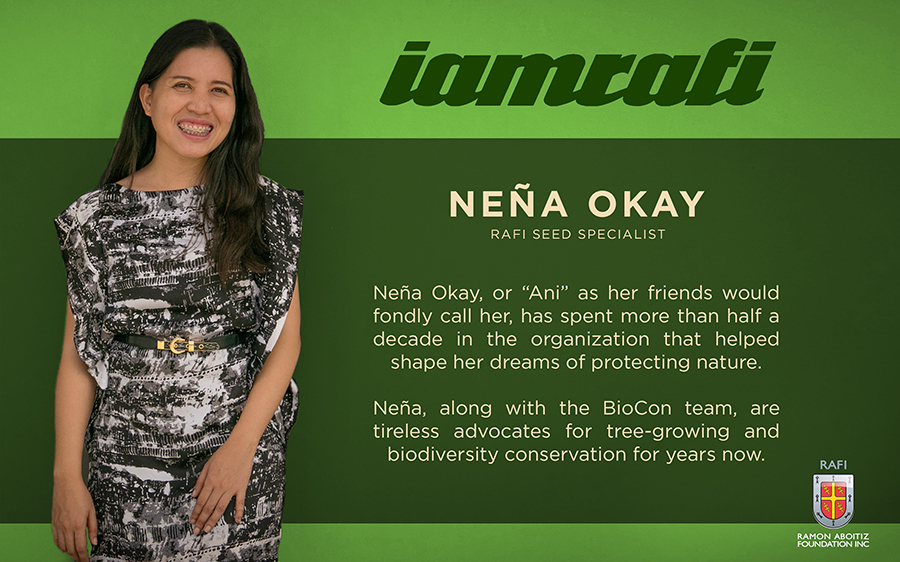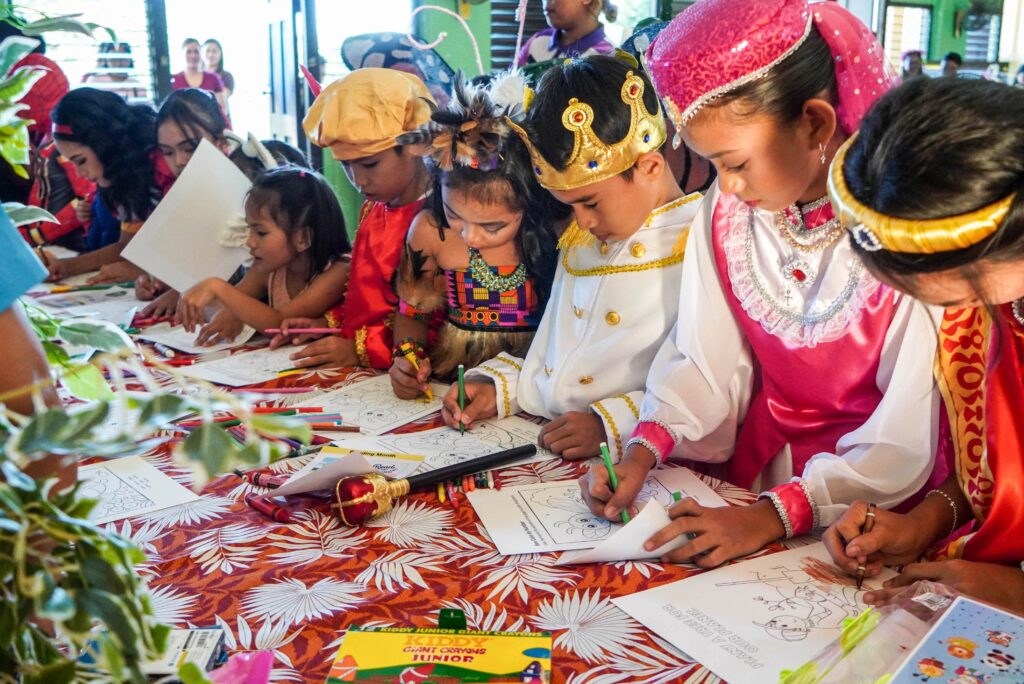
The story of Neña Okay, Forester, Ramon Aboitiz Foundation Inc. Biodiversity Conservation Program (RAFI-BioCon), 7 years in service
by Joy Emma Masapequena | February 17, 2020
The Tree That Changed It All
In one of their field activities when she was in Grade 6, she met a forester who showed her the leaves of a Narra tree. With just one look, the forester was already able to identify the tree, an encounter that quickly gripped her fascination.
“Di jud ko kalimot sa dahon sa Narra, kaila jud ko ana. Then pag-abot sa college, dali ra kayo sa ako magtan-aw ug dahon (I can never forget the time I saw the leaves of Narra, I really know it. When I got to college, it was very easy for me to identify leaves),”
As a child, she witnessed how her father, a farmer-carpenter, would use numerous techniques on choosing wood suitable for the project he’s working on.
“Sauna akong tatay maghimo man ug sala set, mga cabinet. Ang fresh diay nga Narra if you put it in the water kay mu-green diay ang tubig. So, akoang mata kay anad na daan (My father used to make sala sets, cabinets and I learned that fresh Narra leaves a green tinge if you soak it in water),”
She marveled at the way these people were able to know the names of the trees, as if they were just greeting an old friend.
This fascination continued on even when she entered college, but never really entertained the idea of working with trees as she never really saw it as a profession. She traversed a somewhat practical route at that time – engineering.
From Engineering to Forestry
Growing up, Neña has always set her eyes on engineering as a career that she wanted to pursue. Until a friend told her that in engineering, “ma-losyang ra ka (you’ll age faster),” and later convinced her to try out another course.
Skeptical, she wanted to try out the classes first before shifting. She recalled that in one of the classes, she discovered that a profession such as Forestry existed and the professor at that class basically “brainwashed” her into shifting.
“I really learned to love it. Instead of transferring, gi-sturya ko sa Dean nga, “Nen, nindot man ang forestry. It’s an honorable profession, and a dying one kay gamay nalang ta. So help us (the Dean told me, “Nen, foresty is an honorable profession, and a dying one because there’s only a few of us”),”
Thus propelling her to a lifelong journey of campaigning for the preservation of nature.
A Day In The Life of A Forester
As a Forester, she is heavily involved in the germination of seeds until they grow into a seedling. Nowadays, Neña spends most of her time in the office, tending to the operational aspects of her job.
When asked about her favorite part of the job, she answered, “Mura siya’g naa ko’y (I feel like I have a) playground to experiment how to germinate different kind of species,”
“I have the privilege to see different kinds of seeds nga di makita sa uban, labi na mga critically endangered (see seeds that others don’t see, especially the endangered ones). I have the privilege to collect, get and to plant it in the nursery,”
A privilege that not a lot of foresters get to experience.
Another aspect that made her fall in love with being a forester is the opportunity to teach others.
“I also conduct some research and I teach what I know to other people who can also influence others, like the teachers,”
On RAFI’s BioCon
At its core, the goal of BioCon and everything that it stands for is pretty self-explanatory – Biodiversity Conservation.
“What we do is to change mindsets,”
People have to understand that environmental conservation and rehabilitation is a personal responsibility. Their identity is guided by this mission to make people realize the value of biodiversity, why we need it, and why there’s a need to conserve it.
Why Tree-Growing?
“What usually happens before is they hold tree-planting activities and then wala na dayon mi kahibaw unsay mahitabo (and then there’s no follow-up that happens after),”
They, therefore, turned to tree-growing rather than just merely tree-planting. This way, they are able to monitor the growth of the tree from germination to its maturity.
“What BioCon offers is the technical side of the implementation,” which explains how they came about as a service-provider for companies and communities who have the resources to plant but lack the technical skills to do so.
Influencing the Influencers
As Neña puts it, “We influence the influencers,” and they have done so over the years through countless projects with teachers, farmers, and corporations.
All these tree-growing projects were made possible by partnering up with people’s organizations (POs) such as the La Mesa Farmer’s Association in Balamban, and the United Farmer’s Cooperative (UNIFAMCO) in Toledo.
They have also connected with the National Greening Program (NGP) School Coordinators – teachers who incorporate BioCon’s tree-growing methods in their classes. They use BioCon’s Tree-Growing Booklet, a tool they developed to help the students monitor their own trees.
Even though they conduct trainings and seminars on tree-growing, they are fairly lenient on the actual implementation of the project by the individuals that they teach. Experience, after all, is the best teacher.
Can Everyone Do It?
YES! However, for Neña, the biggest challenge in tree-growing is not the process of growing trees, but in convincing people to plant them in the first place.
“Changing the mindset of other people would always be a continuous challenge,”
She shared stories of how some people would only plant trees if there’s something in it for them. She reflected how we humans could be so self-serving when it comes to changing the world. For her, tree-growing is a selfless venture.
Their aim is for tree-growing to be something that’s self-initiated, fueled by a sincere regard for the health of our world.
“Us, breathing – it’s our responsibility. Clean air, clean water,”
What comes around, goes around, and in the end, we are the ones who reap the consequences of what we do.
How She Does It
How can one conquer the challenge of protecting nature?
“Don’t do it alone,” she said.
Just like in nature, we are all connected. Every single thing that every single human does affects us. It is a complex ecosystem, and one way to maneuver through this labyrinthine complication is to consider other people – to see the world outside of yourself.
“Before, we were very nature-centered, but now we focus on the people and their livelihood. Ang project nimo mu-augment ug income para sila magchange ug mindset (We augment our projects with ways that they can generate income to help change their mindset),”
By doing so, the people on field now have more reason to grow trees and not just plant them.
Standpoint: Practice Over Preach
Neña Okay leads a simple life. One that’s full of enthusiasm and passion for environmental conservation and rehabilitation. She sees the world in awe simply because she recognizes the beauty of nature as it is – grubby, wild, and very much…alive!
She doesn’t only preach the technicalities of what we should be doing but leads by doing it herself first. Some might call her, and others in her field as “nature-lovers”, but their love and dedication to their cause goes deeper than that. They are rooted to the belief that humans are innately in love with nature. As with any love, we shouldn’t just settle for words, but actions too.
#IAMRAFI


